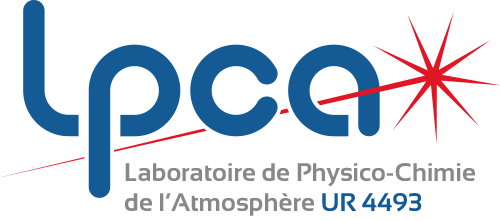FIXED AND MOBILE OBSERVATION PLATFORMS
The Laboratory has developed 2 instrumented simulation chambers for studying the reactivity of VOCs with the main atmospheric oxidants (OH and NO3 radicals, ozone and Cl atoms).
- CHARME (CHamber for Atmospheric Reactivity and Metrology of the Environment)
- Cylindrical chamber in electropolished 304 L stainless steel
- V = 9,2 m3 (S/V = 2,4 m-1)
- T° = -20°C à +50°C
- P = 0,15 – 103 hPa
- 4 xenon lamps (5 kW)
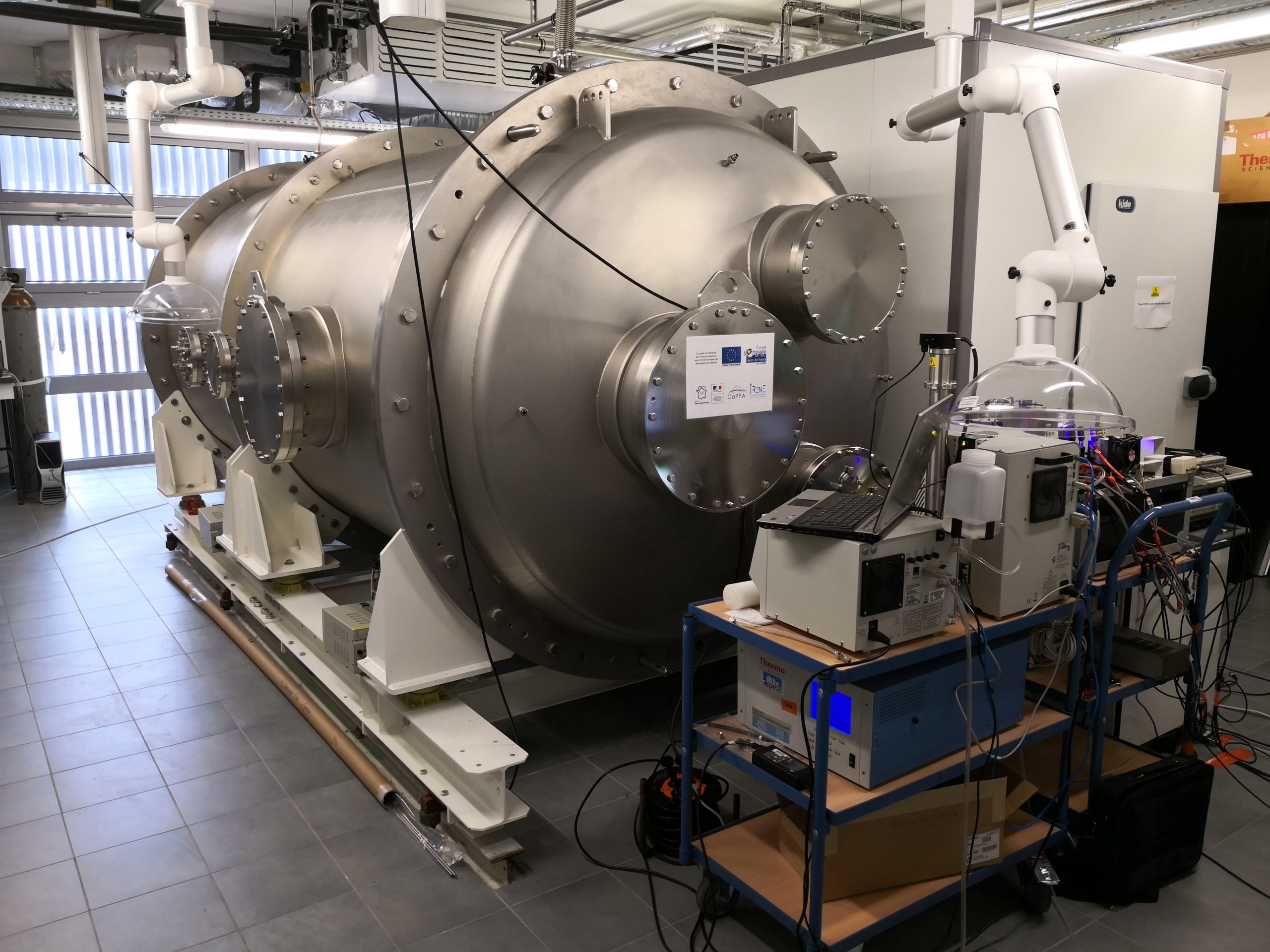
CHARME (CHamber for Atmospheric Reactivity and Metrology of the Environment)
- LPCA-one :
- PMMA (polymethyl methacrylate) cubic chamber
- V = 8 m3 (S/V = 3 m-1)
- T° = 20 ± 2°C
- P = 103 hPa
- 10 fluorescent tubes (Philips TLD 58W/965) : 400-800 nm.
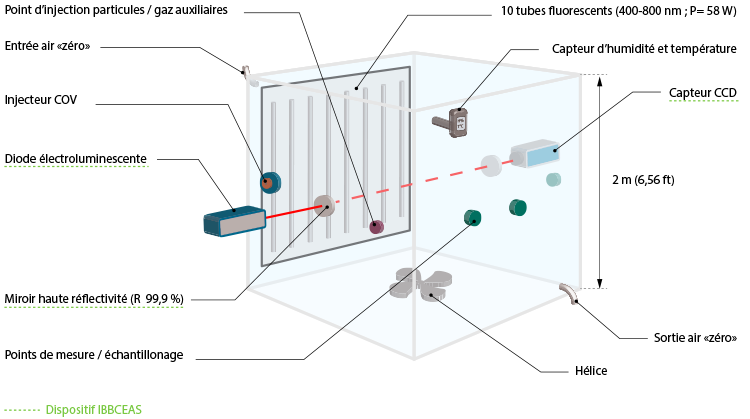
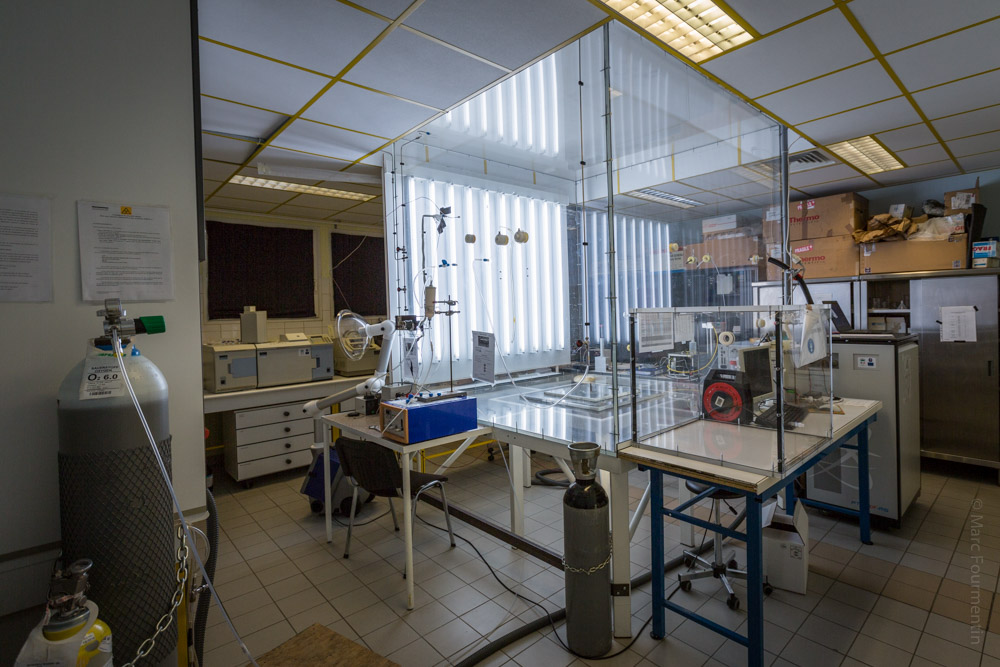
LPCA-One
Instrumentation associated with ASCs
| Instrument | Species Detected / Detection Limit |
Temperature / humidity probe (Sensirion EK-H5 – Sensor SHT75) | T° : -40°C – 124°C RH : 0 – 100 % |
Ozone Analyzer (UV Photometry) Thermo Scientific 49i | 0,5 ppb – 200 ppm |
NOx Analyzer (Chemiluminescence) Thermo Scientific 42i | 0,4 ppb – 100 ppm |
ATD400 – GC (Autosystem XL) – FID / MS (Turbomass), Perkin Elmer on-line et off-line | COV / ppb-ppm Aerosols (sampling on stripper/filter) |
Turbomatrix – GC (Autosystem XL) – FID off-line, Perkin Elmer | COV / ppb-ppm Aerosols (sampling on stripper/filter) |
| PTR-ToF-MS, IONICON 1000 | COV / ppt-ppb |
| SMPS, Grimm 5.404 | aerosols short DMA : 5 – 350 nm long DMA : 10 – 1000 nm 107 P.cm-3 |
| CPC (TSI 3010) | 10 – 3000 nm 104 P.cm-3 |
| OPC (Grimm 1108) | 0.3 – 20 µm 0.1 – 100 000 µg.m-3 |
| IBBCEAS in-situ (660 nm) | NO3 / 6 ppt (3 min) NO2 / 3 ppb (3 min) |
| Multipass absorption EC-QCL (8 µm) | N2O5 / 20 ppb (25 s) |
| Aerosol generator (TSI 3076) + dryer (TSI 3062) | Aerosol generation 2.106 P.cm-3 (108 P.s-1) 15 – 400 nm |
Characterization of atmospheric particles by electron microscopy
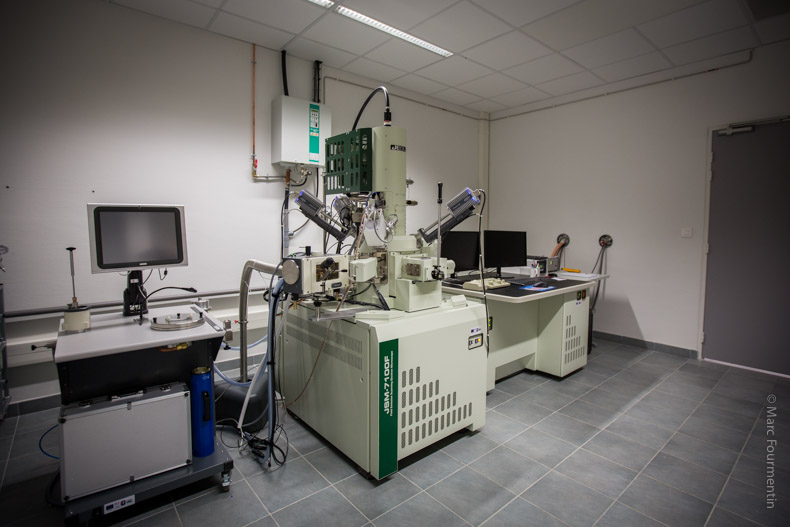
The laboratory is equipped with a JEOL JSM7100F field effect scanning electron microscope, dedicated to the analysis of atmospheric particles. In addition to conventional secondary and backscattered electron detectors, it is equipped with:
– a transmitted electron detector
– three EDX Bruker QUANTAX 800 spectrometers (3 x 30 mm2)
– an automated particle detection and analysis system
– a QUORUM PP3010T cryogenic stage for observing semi-volatile aerosols at liquid nitrogen temperature.
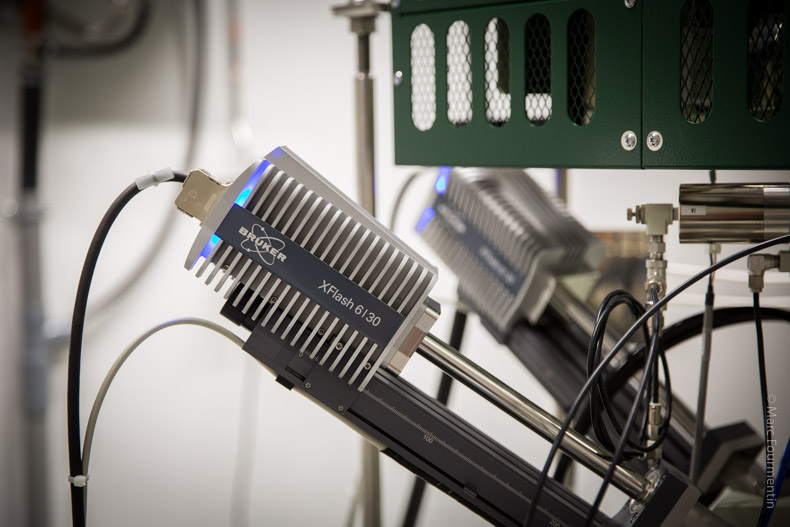
PSampling of Atmospheric Aerosols
The Laboratory has at its disposal tools for conventional sampling of atmospheric aerosols, such as cascade impactors allowing particles to be sampled by seriating them in size (Figure 1), devices which can accommodate supports particularly suited to analytical microscopy, such as boron pellet supports, specifically developed by the laboratory (Figure 2).
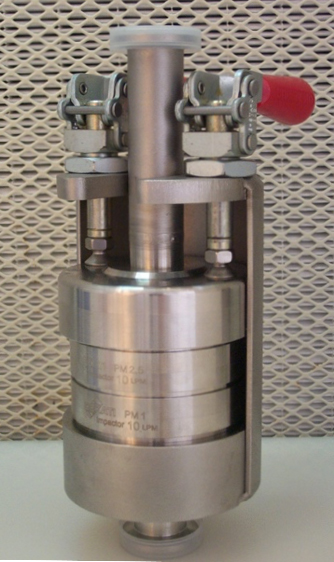
Figure 1 : Typical three-stage cascade impactor Dekati® PM10
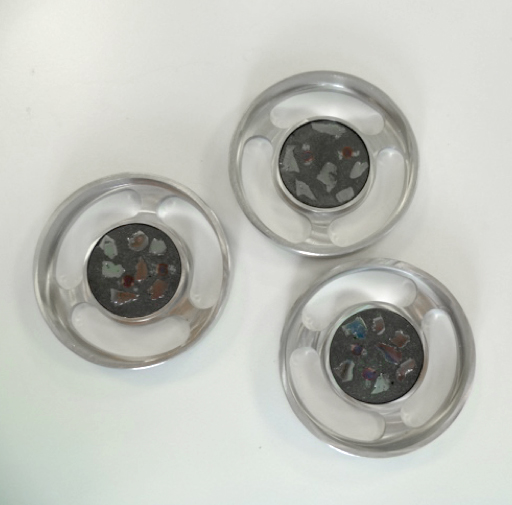
Figure 2 : Boron supports allowing the collection and automated analysis of thousands of particles per sample, by microanalysis X
In recent years, we have more specifically focused on developing means of airborne aerosol sampling, such as the tethered balloon below (Figure 3) allowing sampling up to 200 m altitude, within the plumes of industrial emissions.
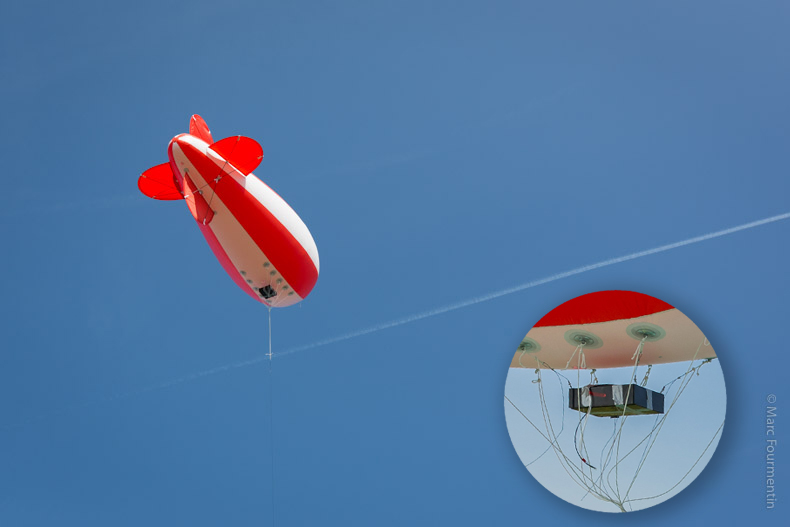
Figure 3 : Captive airship used in particular for sampling within emission plumes
Atmospheric Aerosol Analysis
• Analytical Microscopy
Characterization of atmospheric particles by electron microscopy (FEG-TSEM system described above)
• Analysis of trace elements
The Laboratory has an “ISO 6” Controlled Dust Room (ex-class 1000), comprising “ISO 5” type zones (ex-class 100 laminar flow chamber).
This “White Room” (figure 4) is intended in particular for preparative chemistry before elemental analysis (example: heavy metals), by the usual techniques of Atomic Spectrometry (ICP-MS in particular), as well as for purification prior to analyzes isotopic (Pb, Fe, Cu, Zn,..) carried out in collaboration with the Free University of Brussels (Prof. Nadine Mattielli).
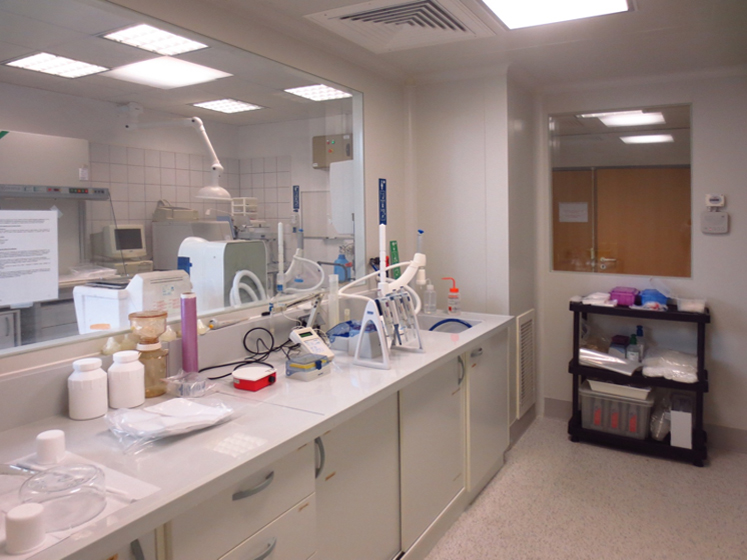
Figure 4 : View of the LPCA ISO 6 Clean Room
Atmospheric Mobile Unit (UMA)

The Atmospheric Mobile Unit (UMA)
The Mobile Atmospheric Unit (UMA) was created thanks to the support, under the BQR 2016, of the University of the Littoral Côte d’Opale (ULCO). This aid made it possible to restructure an already existing “LIDAR truck” into a functional and versatile device allowing the study of the effects of the dynamics of the atmosphere on pollutants and their consequences on health. This mobile unit is capable of providing response elements through multi-scale measurement campaigns in the field, by combining remote sensing and in-situ measurements during different episodes of atmospheric phenomena, including sea breezes, which are very frequent. in coastal regions.
UMA’s equipment represents a very diverse instrumental panel that can document atmospheric dynamics, the physico-chemical characteristics and optical properties of aerosols, as well as the level of toxicity of pollutants. Indeed the UMA currently allows the simultaneous integration of four main fully removable modules, consisting of field or laboratory measuring instruments adapted to the field:
– Module A: Equipment for the study of atmospheric dynamics
– Module B: Equipment for studying the optical properties of aerosols
– Module C: Equipment for the physico-chemical characterization of aerosols
– Module D: Equipment for the toxicological study of gases and aerosols
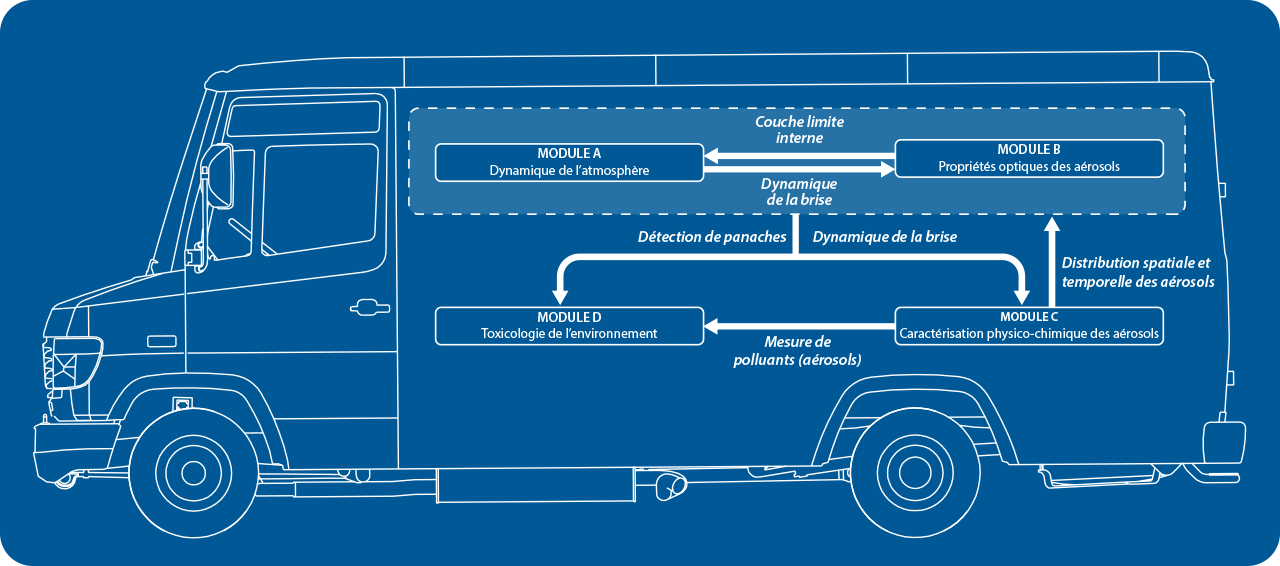
UMA Constituent Modules
This mobile unit is completely autonomous, powered by an 18 kVA trailer-mounted generator (including 9 kVA on a corrugated electrical network). The passenger compartment is air-conditioned to avoid overheating of the various devices in operation but also to obtain a controlled and stable temperature for certain applications. A ramp system allows the onboarding of “heavy” analysis systems and consumables (gas cylinders, wind LIDAR, measurement racks, etc.). A removable roof allows the rapid deployment of measuring instruments outwards and a pneumatic mast is used to raise certain devices (weather station, ultrasonic anemometer, samples, etc.)
Module A
The systems that can be deployed at the level of Module A, whose objective is to study the dynamics of the atmosphere in order to define the meteorological mechanisms likely to play a role in the variability of atmospheric pollutants, are currently the following:
- LIDAR and SODAR wind profilers
- Weather Channel
- Ultrasonic Anemometers
- Aerosol LIDAR
- Radiosoundings
Module B
The systems that can be deployed at Module B, whose objective is to determine the impact of atmospheric phenomena on the evolution of the spatial distribution of aerosols, are currently the following:
- Aerosol LIDAR
- IBBCEAS
Module C
The systems that can be deployed at Module C, whose objective is the study of the aging of inorganic aerosols and the evolution of the mixing state, are currently the following:
- Portable glove box for filter preparation
- Particle counters
- SMPS
- Cascading impactors
- Captive balloon equipped (cascade impactor, particle counter, PTH weather probe, etc.)
Module D
The systems that can be deployed at the Module D level, whose objective is the study of the impact of the dynamics of the atmosphere on the toxicity of gases and aerosols, are currently the following:
Vitrocell® Cell Exposure Chamber
The fine combined analysis of the parameters measured at the level of the different modules is made possible by the deployment of instruments with a temporal resolution adapted to the time scale of the atmospheric phenomena encountered.
Depending on the objectives of the measurement campaigns, additional observation means can be used, such as gas analyzers (NOx, CO, SO2, O3, BTEX, VOCs, etc.) from the ULCO CCM mobile laboratory.
